
Iranian monarchism is the advocacy of restoring the monarchy in Iran, which was abolished after the 1979 Revolution.

Iranian monarchism is the advocacy of restoring the monarchy in Iran, which was abolished after the 1979 Revolution.
Iran, in its various known forms, beginning with the Median dynasty, was a monarchy (or composed of multiple smaller monarchies) from the 7th century BCE until 1979.
It first became a constitutional monarchy in 1906 under the Qajar dynasty, but underwent a period of autocracy during the years 1925–1941 during the rule of Reza Shah, who, after staging a coup d'état that led to the founding of the Pahlavi dynasty, imposed self-rule. Parliament became a rubber stamp, the press was censored and the Communist Party and trade unions banned. [1] After Reza Shah's abdication in 1941, the Iranian National Assembly was restored to power. During the years 1941 to 1953, Iran remained a constitutional monarchy and active parliamentary democracy with Shah Mohammad Reza Pahlavi retaining extensive legal executive powers.
On March 15, 1951, the National Assembly, led by Prime Minister Hossein Ala, unanimously voted to nationalize the oil industry, which at the time was dominated by the Anglo-Iranian Oil Company (now BP). In 1953, the British MI6 and American CIA orchestrated a coup against Mohammed Mossadegh's government. Agents fueled rumors that the republican-minded Mossadegh was planning on abolishing the monarchy and declaring himself president of a new Republic of Iran, leading to a pro-monarchist backlash from the public and leading to a successful result in the coup against the prime minister.
The Shah, who had gone into exile during the coup, returned to Iran and named General Fazlollah Zahedi as the new prime minister. Many contemporary sources attribute the coup, or counter coup, entirely to the U.S. American CIA and agents of the British MI6 who are reported to have organized and paid for it. [2] These sources point to many other coups in which the CIA was instrumental, such as that in Chile in 1973. Monarchists, however, argue that the counter-coup was in fact a popular uprising, and that the foreign intelligence agencies' undeniable involvement was peripheral. At least some historians argue the coup could not have taken place without both CIA organizing and Iranian support. [3] [4]
Afterwards, the era of constitutional monarchy gradually came to an end as the Shah increasingly exercised his executive powers unilaterally, thus leading towards the development of autocracy. By the early 1970s, with most political parties having been banned, Iran had effectively become a one-party state under the royalist Rastakhiz Party. National Front leaders like Karim Sanjabi and moderate traditional Islamic leaders like Mohammad Kazem Shariatmadari continued to espouse a constitutional monarchy.
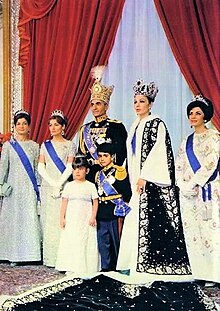
Under increasing international pressure, particularly from President Jimmy Carter of the United States, the Shah pushed forward major democratic reforms in the late 1970s, designed to gradually restore the constitutional monarchy as it had originally been. However, several uprisings in 1978 and 1979 culminated in the Shah, who had been diagnosed with terminal cancer and had kept the fact secret, leaving the country with his family to seek treatment overseas. Within a few weeks the Shah's government had effectively collapsed and the Second Revolution had begun. The new provisional revolutionary government officially abolished the monarchy and declared Iran to be a republic. In April 1979, the Islamic Republic of Iran was established, under the Supreme Leadership of Ruhollah Khomeini.
In the months following the Revolution, former Field Marshal of the Imperial Armed Forces Bahram Aryana organized a counter-revolution in exile. Based in Paris, France, with other military officials of the Imperial Armed Forces and Prince Shahriar Shafiq, he established Azadegan, a paramilitary resistance intended to help restore the constitutional monarchy. Fearing a growing counter-revolution, Prince Shahriar was assassinated in Paris in December 1979 by Khomeinist agents, which was a major setback for the monarchist resistance. Despite a number of successful operations which garnered international media attention in 1980 and 1981, the outbreak of war between Iran and Iraq officially brought any hope for counter-revolution to an end.
In the 1990s and the decade following 2000, the Shah's reputation has staged something of a revival, with many Iranians looking back on his era as a time when Iran was more prosperous [5] [6] and the government less oppressive. [7] Journalist Afshin Molavi reports even members of the uneducated poor — traditionally core supporters of the revolution that overthrew the Shah — making remarks such as 'God bless the Shah's soul, the economy was better then;' and finds that "books about the former Shah (even censored ones) sell briskly," while "books of the Rightly Guided Path sit idle." [8]
The former Crown Prince of Iran, Reza Pahlavi, himself does not advocate the restoration of his dynasty, instead stating that the matter is for Iranians themselves to decide in a national referendum whether or not to restore the constitutional monarchy with the restoration of the House of Pahlavi. [9]
| Part of a series on |
| Conservatism in Iran |
|---|
  |

Mohammad Mosaddegh was an Iranian politician, author, and lawyer who served as the 30th Prime Minister of Iran from 1951 to 1953, elected by the 16th Majlis. He was a member of the Iranian parliament from 1923, and served through a contentious 1952 election into the 17th Iranian Majlis, until his government was overthrown in the 1953 Iran coup aided by the intelligence agencies of the United Kingdom (MI6) and the United States (CIA), led by Kermit Roosevelt Jr. His National Front was suppressed from the 1954 election.

The 1953 Iranian coup d'état, known in Iran as the 28 Mordad coup d'état, was the U.S.- and British-instigated, Iranian army-led overthrow of the Prime Minister Mohammad Mosaddegh in favor of strengthening the autocratic rule of the shah, Mohammad Reza Pahlavi, on 19 August 1953, with the objectives being to protect British oil interests in Iran after its government refused to concede to western oil demands. It was instigated by the United States and the United Kingdom. This began a period of dissolution for Iranian democracy and society whose effects on civil rights are prevalent to this day.

Fazlollah Zahedi was an Iranian military officer and statesman who replaced the Iranian Prime Minister Mohammad Mosaddegh through a coup d'état supported by the United States and the United Kingdom.
The Tudeh Party of Iran is an Iranian communist party. Formed in 1941, with Soleiman Mirza Eskandari as its head, it had considerable influence in its early years and played an important role during Mohammad Mosaddegh's campaign to nationalize the Anglo-Persian Oil Company and his term as prime minister. From the Iran crisis of 1946 onwards, Tudeh became a pro-Soviet organization and remained prepared to carry out the dictates of the Kremlin, even if it meant sacrificing Iranian political independence and sovereignty. The crackdown that followed the 1953 coup against Mosaddegh is said to have "destroyed" the party, although a remnant persisted. The party still exists but has remained much weaker as a result of its banning in Iran and mass arrests by the Islamic Republic in 1982, as well as the executions of political prisoners in 1988. Tudeh identified itself as the historical offshoot of the Communist Party of Persia.
The National Front of Iran is an opposition political organization in Iran. It was founded by Mohammad Mosaddegh in 1949, and it is the oldest and arguably the largest pro-democracy group operating inside Iran, despite having never been able to recover the prominence it had in the early 1950s.

The Pan-Iranist Party is an opposition political party in Iran that advocates pan-Iranism. The party is not registered and is technically banned, however it continues to operate inside Iran.

The Party of Resurrection of the Iranian Nation, or simply the Rastakhiz Party, was Iran's sole legal political party from 2 March 1975 until 1 November 1978, founded by Mohammad Reza Shah.

All the Shah's Men: An American Coup and the Roots of Middle East Terror is a book written by American journalist Stephen Kinzer. The book discusses the 1953 Iranian coup d'état backed by the U.S. Central Intelligence Agency (CIA) in which Mohammed Mossadegh, Iran's democratically elected prime minister, was overthrown by Islamists supported by American and British agents and royalists loyal to Shah Mohammad Reza Pahlavi.
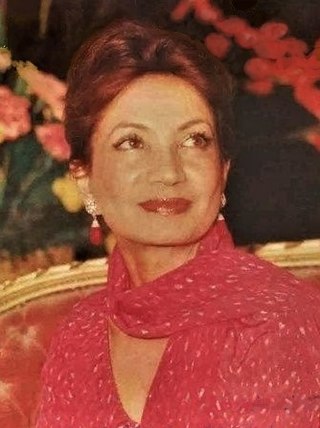
Ashraf ol-Molouk Pahlavi was the twin sister of Mohammad Reza Pahlavi, the late Shah of Iran (Persia), and a member of the Pahlavi dynasty. She was considered the "power behind her brother" and was instrumental in the 1953 coup that overthrew Prime Minister Mohammad Mosaddegh in favour of strengthening the monarchical rule of the Shah. She served her brother as a palace adviser and was a strong advocate for women's rights. Following the Iranian Revolution in 1979, she lived in exile in France, New York, Paris and Monte Carlo and remained outspoken against the Iranian Islamic Republic.

Hossein Fatemi was an Iranian scholar. A close associate of Prime Minister Mohammad Mosaddegh, he proposed nationalization of Iranian oil and gas assets. Initially a journalist, he served as minister of foreign affairs from 1951 to 1953. After the 1953 coup d'état toppled the government of Mosaddegh, Fatemi was arrested, tortured, and convicted by a military court of "treason against the Shah", and executed by a firing squad.

Assadollah Rashidian was an Iranian businessman and anglophile who, along with his brothers, played a critical role in the 1953 overthrow of Iranian Prime Minister Mohammed Mossadegh. He was a principal covert agent of the British Secret Intelligence Service (SIS) and through him the U.S. Central Intelligence Agency (CIA) was able to convince the Shah, Mohammed Reza Pahlavi, to endorse the operation.

Karim Bakhtiar Sanjabi was an Iranian politician, a member of The National Consultative Assembly. He was also a professor at Tehran University Law School and one of the leaders of Iran National Front and Iran Party. Sanjabi was also considered the Minister of Culture in the government of Mohammad Mosaddegh and the Minister of Foreign Affairs of Iran in the government of Mahdi Bazargan.
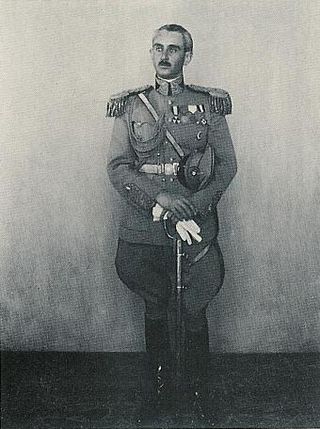
Hasan Arfa was an Iranian general and ambassador to the Pahlavi dynasty.
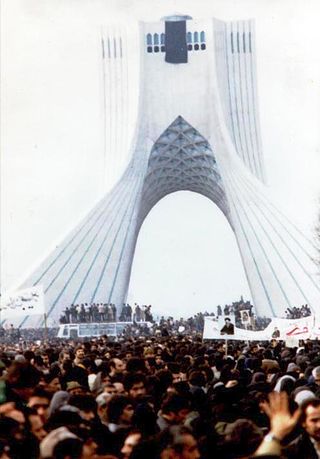
This article is a timeline of events relevant to the Islamic Revolution in Iran. For earlier events refer to Pahlavi dynasty and for later ones refer to History of the Islamic Republic of Iran. This article doesn't include the reasons of the events and further information is available in Islamic revolution of Iran.

Mozzafar Baghai is known best as an Iranian political figure of the 1940s and 1950s. He rose to prominence during the national struggle against British control of Iran's oil industry. For decades, most Iranians had resented the Anglo-Iranian Oil Company for the perceived injustice of allocating most profits to the company and the British government, while only a very small proportion was given to Iran, despite the fact that the oil fields were on Iranian territory. Baghai made himself known as a fiery critic of the British and he allied himself with those of like mind, including Dr. Mohammad Mossadegh. He was different from many other nationalists in that he held very left-wing views. He was able to best articulate this when he formed the Toilers Party of the Iranian Nation, a left-wing, nationalistic and anti-communist party that included such notables as Khalil Maleki. In 1949, the Toilers Party joined with Mossadegh and his liberal supporters in forming the National Front of Iran, which was an umbrella organization for all Iranians who were committed to the principles of freeing Iran from foreign domination, ending arbitrary rule and establishing a government dependent on the will of the people of Iran. In April 1951, one month after the oil industry was nationalized by the Majlis, Mossadegh was chosen by that elected body as the Prime Minister of Iran, subject to approval by the reigning Mohammad Reza Shah.

Mohammad Reza Pahlavi, commonly referred to in the Western world as Mohammad Reza Shah, or simply the Shah, was the last monarch of Iran (Persia). In 1941 he succeeded his father Reza Shah and ruled the Imperial State of Iran until 1979 when the Iranian Revolution overthrew him, abolished the monarchy and established the Islamic Republic of Iran. In 1967, he took the title Shahanshah, and also held several others, including Aryamehr and Bozorg Arteshtaran. He was the second and last ruling monarch of the Pahlavi dynasty. His vision of the "Great Civilization" led to his leadership over rapid industrial and military modernization, as well as economic and social reforms in Iran.
A referendum on the dissolution of Parliament, the first referendum ever held in Iran, was held in August 1953. The dissolution was approved by more than 99% of voters.
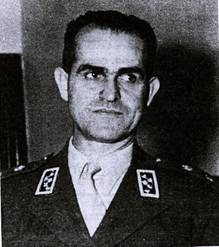
Mahmoud Afshartous, also written Afshartoos, was an Iranian general and chief of police during the government of Prime Minister Mohammad Mossadegh. Afshartous was abducted and killed by anti-Mossadegh conspirators led by MI6 which helped pave the way for the 1953 coup d'état.
Azadeh Shafiq was an Iranian royal and a member of the Pahlavi dynasty, being daughter of Ashraf Pahlavi. Following the Iranian revolution that toppled her uncle, Mohammad Reza Pahlavi, she exiled in Paris and involved in opposition activities to the Islamic regime in Iran.

The Imperial State of Iran, officially known in English as the Imperial State of Persia until 1935, and commonly referred to as Pahlavi Iran, was the Iranian state under the rule of the Pahlavi dynasty. The Pahlavi dynasty was created in 1925 and lasted until 1979, when it was ousted as part of the Islamic Revolution, which ended the Iranian monarchy and established the current Islamic Republic of Iran.